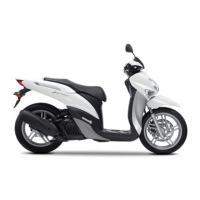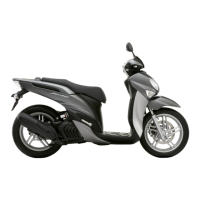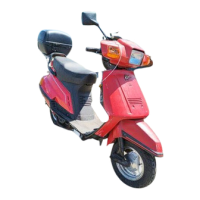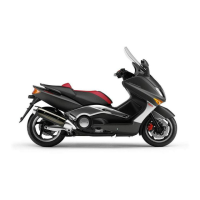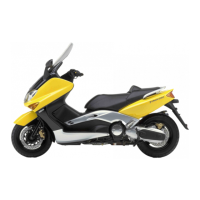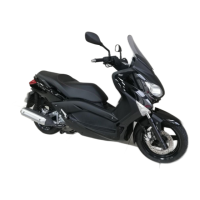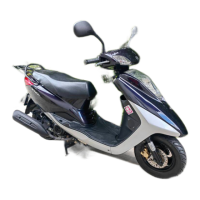Do you have a question about the Yamaha Xenter 125 2011 and is the answer not in the manual?
Guidance on owner responsibilities for safe operation and maintenance.
Tips and practices for safe operation of the scooter.
Recommendations for rider protective gear to minimize injury.
Precautions and dangers of carbon monoxide exposure from exhaust.
Guidelines for safely adding cargo or accessories to the scooter.
Information on approved accessories and their benefits.
Risks and guidelines for using non-genuine parts and modifications.
Considerations for choosing and using aftermarket tires and rims.
Instructions for safely securing the scooter for transport.
Additional important tips for safe riding practices.
Identification of major components on the left side of the scooter.
Identification of major components on the right side of the scooter.
Overview and location of the scooter's controls and instruments.
Operation and functions of the ignition and steering lock.
Explanation of dashboard indicator and warning lights.
Details on the multi-function display, its modes, and indicators.
Description and operation of left and right handlebar switches.
Location and operation of front/rear brake levers and fuel cap.
Information on fuel type, capacity, and refueling precautions.
Information on the catalytic converter and its operating precautions.
Procedures for opening seat and storage compartments.
Information on shock absorber assembly, carrier, and luggage holder.
Checks for fuel level and leakage before operation.
Checks for engine oil level and leakage.
Check for oil leakage in the final transmission.
Check coolant level and for coolant system leakage.
Check operation, fluid level, and pad wear.
Check operation, lever free play, and adjust.
Check operation, free play, and lubricate.
Check operation and lubricate if necessary.
Check for damage, tread depth, and tire pressure.
Check operation and lubricate pivot points.
Check operation and lubricate pivot.
Check operation and correct if necessary.
Step-by-step guide to starting the engine.
Procedure for safely moving the scooter off the centerstand and starting to ride.
How to control speed using the throttle grip.
Techniques for applying brakes safely and effectively.
Advice on how to improve fuel efficiency during riding.
Instructions for the initial 1000 km period to ensure engine longevity.
Safe procedures for parking the scooter.
Location and use of the tools provided with the scooter.
Scheduled maintenance tasks for emission control components.
Comprehensive chart for periodic maintenance and lubrication tasks.
Instructions for removing and reinstalling body panels for maintenance.
Procedure for checking the condition and gap of the spark plug.
How to check engine oil level and change oil/clean strainer.
Procedure for checking and changing final transmission oil.
How to check coolant level and change coolant.
Cleaning or replacing air filter and V-belt case filter elements.
How to check and adjust the engine's idling speed.
How to check and adjust throttle grip free play.
Information on valve clearance adjustment by a dealer.
Correct tire air pressure specifications and checks.
Procedures for inspecting tire condition and tread depth.
Inspection and balancing of cast wheels.
Procedure to check front brake lever free play.
Procedure to adjust rear brake lever free play.
Checking wear on front brake pads and rear brake shoes.
How to check the brake fluid level and precautions.
Procedure for changing brake fluid, oil seals, and hoses.
Checking and lubricating control cables.
Checking and lubricating the throttle grip and cable.
Lubrication of front and rear brake lever pivot points.
Checking and lubricating the centerstand operation.
Checking the condition and operation of the front fork.
Checking for wear or looseness in steering bearings.
Checking front and rear wheel bearings for play or damage.
Information on the VRLA battery and its lead connections.
Procedure for replacing blown fuses.
How to replace a burnt-out headlight bulb.
Checking the LED tail/brake light.
How to replace a burnt-out front turn signal bulb.
How to replace a burnt-out auxiliary light bulb.
How to replace a burnt-out rear turn signal bulb.
Checking the license plate light operation.
General advice on troubleshooting scooter problems.
Charts for diagnosing starting problems or poor engine performance.
Procedures and warnings for handling engine overheating.
Precautions for cleaning matte colored parts.
General advice on maintaining the scooter's appearance and performance.
Detailed instructions and precautions for cleaning the scooter.
Guidelines for short-term and long-term storage of the scooter.
Overall physical dimensions and curb weight of the scooter.
Engine type, displacement, bore, stroke, compression ratio, and oil.
Recommended fuel, tank capacity, and air filter type.
Spark plug model/gap and clutch type details.
Gear ratios, transmission type, and frame type.
Front/rear wheel type, rim size, tire size, and manufacturer.
Front/rear brake type, operation, fluid, and suspension details.
Ignition, charging system, battery model, voltage, and capacity.
Bulb types, voltages, wattages for lights and indicators.
Amperage ratings for all vehicle fuses.
Location and importance of vehicle identification numbers.
Location where the VIN is stamped on the frame.
Location of the model label on the seat.
Guidance on owner responsibilities for safe operation and maintenance.
Tips and practices for safe operation of the scooter.
Recommendations for rider protective gear to minimize injury.
Precautions and dangers of carbon monoxide exposure from exhaust.
Guidelines for safely adding cargo or accessories to the scooter.
Information on approved accessories and their benefits.
Risks and guidelines for using non-genuine parts and modifications.
Considerations for choosing and using aftermarket tires and rims.
Instructions for safely securing the scooter for transport.
Additional important tips for safe riding practices.
Identification of major components on the left side of the scooter.
Identification of major components on the right side of the scooter.
Overview and location of the scooter's controls and instruments.
Operation and functions of the ignition and steering lock.
Explanation of dashboard indicator and warning lights.
Details on the multi-function display, its modes, and indicators.
Description and operation of left and right handlebar switches.
Location and operation of front/rear brake levers and fuel cap.
Information on fuel type, capacity, and refueling precautions.
Information on the catalytic converter and its operating precautions.
Procedures for opening seat and storage compartments.
Information on shock absorber assembly, carrier, and luggage holder.
Checks for fuel level and leakage before operation.
Checks for engine oil level and leakage.
Check for oil leakage in the final transmission.
Check coolant level and for coolant system leakage.
Check operation, fluid level, and pad wear.
Check operation, lever free play, and adjust.
Check operation, free play, and lubricate.
Check operation and lubricate if necessary.
Check for damage, tread depth, and tire pressure.
Check operation and lubricate pivot points.
Check operation and lubricate pivot.
Check operation and correct if necessary.
Step-by-step guide to starting the engine.
Procedure for safely moving the scooter off the centerstand and starting to ride.
How to control speed using the throttle grip.
Techniques for applying brakes safely and effectively.
Advice on how to improve fuel efficiency during riding.
Instructions for the initial 1000 km period to ensure engine longevity.
Safe procedures for parking the scooter.
Location and use of the tools provided with the scooter.
Scheduled maintenance tasks for emission control components.
Comprehensive chart for periodic maintenance and lubrication tasks.
Instructions for removing and reinstalling body panels for maintenance.
Procedure for checking the condition and gap of the spark plug.
How to check engine oil level and change oil/clean strainer.
Procedure for checking and changing final transmission oil.
How to check coolant level and change coolant.
Cleaning or replacing air filter and V-belt case filter elements.
How to check and adjust the engine's idling speed.
How to check and adjust throttle grip free play.
Information on valve clearance adjustment by a dealer.
Correct tire air pressure specifications and checks.
Procedures for inspecting tire condition and tread depth.
Inspection and balancing of cast wheels.
Procedure to check front brake lever free play.
Procedure to adjust rear brake lever free play.
Checking wear on front brake pads and rear brake shoes.
How to check the brake fluid level and precautions.
Procedure for changing brake fluid, oil seals, and hoses.
Checking and lubricating control cables.
Checking and lubricating the throttle grip and cable.
Lubrication of front and rear brake lever pivot points.
Checking and lubricating the centerstand operation.
Checking the condition and operation of the front fork.
Checking for wear or looseness in steering bearings.
Checking front and rear wheel bearings for play or damage.
Information on the VRLA battery and its lead connections.
Procedure for replacing blown fuses.
How to replace a burnt-out headlight bulb.
Checking the LED tail/brake light.
How to replace a burnt-out front turn signal bulb.
How to replace a burnt-out auxiliary light bulb.
How to replace a burnt-out rear turn signal bulb.
Checking the license plate light operation.
General advice on troubleshooting scooter problems.
Charts for diagnosing starting problems or poor engine performance.
Procedures and warnings for handling engine overheating.
Precautions for cleaning matte colored parts.
General advice on maintaining the scooter's appearance and performance.
Detailed instructions and precautions for cleaning the scooter.
Guidelines for short-term and long-term storage of the scooter.
Overall physical dimensions and curb weight of the scooter.
Engine type, displacement, bore, stroke, compression ratio, and oil.
Recommended fuel, tank capacity, and air filter type.
Spark plug model/gap and clutch type details.
Gear ratios, transmission type, and frame type.
Front/rear wheel type, rim size, tire size, and manufacturer.
Front/rear brake type, operation, fluid, and suspension details.
Ignition, charging system, battery model, voltage, and capacity.
Bulb types, voltages, wattages for lights and indicators.
Amperage ratings for all vehicle fuses.
Location and importance of vehicle identification numbers.
Location where the VIN is stamped on the frame.
Location of the model label on the seat.
| Displacement | 125 cc |
|---|---|
| Fuel System | Fuel injection |
| Transmission | V-Belt Automatic |
| Seat Height | 785 mm |
| Starting System | Electric |
| Front Suspension | Telescopic fork |
| Rear Suspension | Unit swing |
| Fuel Tank Capacity | 7.4 liters |
| Front Brake | Disc brake |
| Rear Brake | Drum brake |
| Bore x Stroke | 52.4 mm x 57.9 mm |
| Weight | 142 kg (with oil and full fuel tank) |
